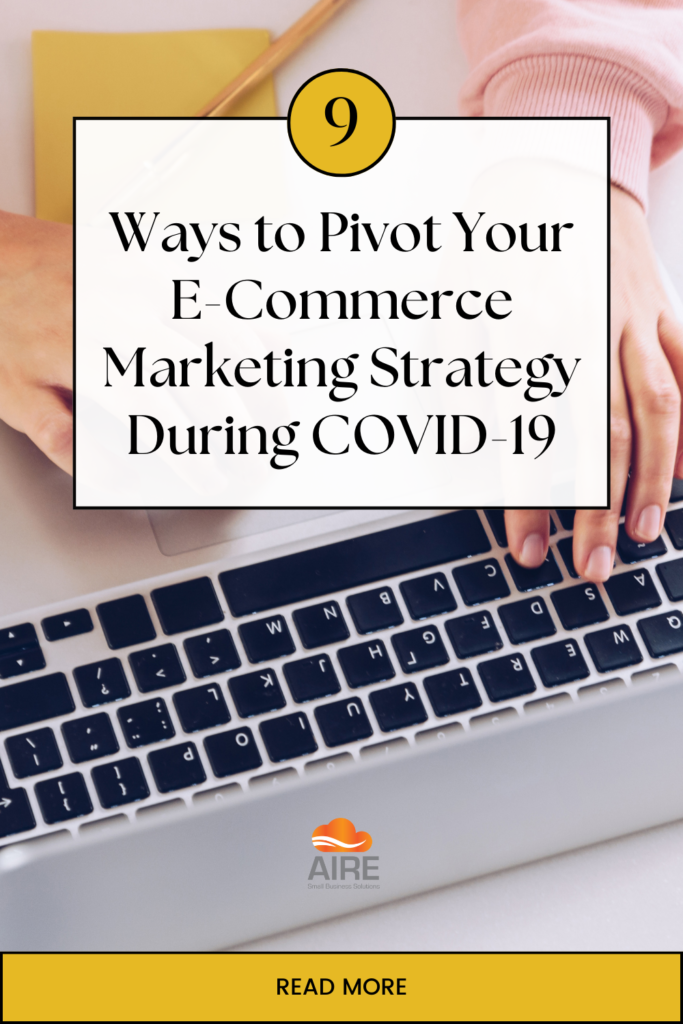Consumers will remember how brands market during the coronavirus outbreak. Realign your marketing strategy for the times with these customer-first suggestions.
The spread of the coronavirus has resulted in sweeping changes to the norm, impacting everything from education, to employment, to how we work. Similarly, smart digital marketers are rapidly adjusting their long-planned strategies in response to COVID-19’s cultural impact.
Bottom-of-the-funnel tactics in a COVID-19 world just will not work like they once did. During times of crisis, marketers must focus less on pushing sales and instead on building trust with their audience and on leveraging generosity and empathy over flashy sales or opportunistic product messaging.
Although consumers may be increasingly guarding their wallets during the coronavirus outbreak, they are also spending more time online than ever. Currently, there is a huge opportunity for digital marketers to thrive, by meeting their audience where they are online and building a strong foundation for long-lasting customer-brand relationships.
9 Ways to Pivot Your Marketing Strategy During COVID-19
1. Communicate about COVID-19 transparently with your customers.
Now is the time to build trust with your customers, not to push sales.
Sending an email to your base about how your business plans to operate during COVID-19 is a great way to start. Remember: transparency is key. Explain how your production cycle will handle (or, has always handled!) sanitary guidelines. Be upfront about any expected changes in your supply chain or in delivery time, and offer solutions to customers that might be impacted by delays. If your company is doing anything extra to help hospitals, charities, or businesses in the wake of the virus, feel free to share that as well.

In these communications, though, marketers should avoid platitudes. Ending with an email sign off of “let me know if there is any way I can help you at this time” may seem like a nice approach, but unless you are truly prepared to send a newly-laid off customer a check in the mail or deliver groceries for their quarantined grandmother, you should avoid making promises that your brand cannot reasonably keep.
Promises you can reasonably keep include:
- A full refund if a product does not arrive within X days due to unforeseen coronavirus-related shipping delays.
- That you will keep them updated on supply issues, and do your best to keep high-demand items in stock.
- That you will maintain a regular schedule of content production to aid and entertain your audience during COVID-19.
- Responsive customer service to any questions they may have.
2. Engage your community in a new way, and become more responsive to your base.
Thanks to new work-from-home policies and many listless hours spent social distancing, consumers are now online more than ever. Instagram Live usage alone has doubled during the coronavirus. As a result, marketers should find ways to engage more frequently with consumers where they are, from following relevant hashtags to starting discussions in online communities.

Many companies are getting creative with their online marketing strategy and connecting on a much deeper level with their base. DTC band MUD\WTR now hosts regular live meditation sessions for its customers. Fitness chain Orange Theory creates daily at-home workout videos for its members, demonstrating how to use items from around the house as free weights while their fitness studios are closed. If it wasn’t already obvious: content is king, especially if it keeps consumers reengaging regularly with your brand.
Finally, if you don’t have one already, consider installing a live chat feature on your site so that you can be extra responsive to your customers. Other great ways to increase your responsiveness are investing in a responsive texting platform or hosting live streams on social media platforms to talk with consumers directly and answer their questions live.
3. Start or further invest in a blog.
According to Privy CMO Dave Gerhardt, “Content is the most important marketing asset in a struggling economy…Content is the thing that gets people to know/like/trust your brand.”
It’s a fact that people love good content. It’s also a fact that, thanks to social distancing, time spent online, on social media, and generally on screens has gone way, way up. Writing content that your audience cares about at a time when they are more likely to consume it (and derive value from it, even if it’s just entertainment) is a great way to build brand trust and awareness.
A blog can also be repurposed in numerous ways your marketing strategy. In addition to building your site’s SEO value and online search discoverability, a blog post can be used across all of your channels to engage with your audience. Promoting blog posts is additionally an extremely low-cost way of driving new top-of-funnel traffic to your site and therefore a great way to test and optimize your mid-funnel conversion tactics like pop-ups and landing pages.
Though the circumstances of our collective distance are not ideal, there is a bright side: studies show creativity flows more when we are alone. Looking for some inspiration? Practice social listening in online communities that members of your customer base typically frequent to discover what topics interest them most.
Don’t have the time to create content on your own? SaaS company Matcha optimizes the blogging experience by providing a library of high-quality and instantly publishable licensed articles from top-publishers, as well as a content marketing platform with conversion tools and insightful content analytics. Licensed content is an easy and cost-effective way to provide value to your brand audience and to discover what topics appeal to them the most.
4. Reevaluate your ad spend.
When struck with a cultural shift as massive as that caused by the COVID-19 outbreak, you should take a hard look at where you are spending advertising dollars. If you were previously relying solely on bottom-of-the-funnel product ads, this tactic may no longer be suitable in a period when consumers are guarding their wallets, especially if you are selling products that are not suitable for the consumer at this time–products related to travel or non-virtual group activities, for example.
Similarly, your top-performing ad from just last month may not resonate in a world of social-distancing. Consider entirely pausing ads that focus on gathering with others or feature imagery of physical connection, such as hugging or handshaking. You will not be alone in this decision–a new study by Pattern89 revealed there are now 27.4% fewer ad images and videos that display physical human interaction.
Instead of product ads, consider leveraging the increased social media usage from COVID-19 as an opportunity to fill your top-of-the-funnel by promoting content ads. Paid content promotions typically drive traffic at a cost up to 90% lower than industry averages and can therefore be used as a cost-effective way to discover the topics your audience most cares about and to drive new traffic and awareness to your site.
5. And audit your ad copy.
The whole world is talking about the coronavirus right now. It is important to take a hyper-sensitive look at your ad copy, because online consumers are definitely doing that. Though your ad from last month that promoted “exploring the world” or “gathering with friends” performed exceedingly well, it is likely to get a hugely negative response if consumers come across it today.

Take for example the ad from Corona, a well-known beer with an unlucky name, for its new seltzer line that was released in late February when the first confirmed cases of COVID-19 were appearing in Washington. In response to Corona’s “Coming ashore soon” slogan, the Twitter community rampaged, accusing the brand of exploiting a global health crisis.
Now obviously the Corona beer case is extreme. But the lesson is clear: no matter the size of your business, your messaging in the time of COVID-19 will not go unnoticed by your audience.
6. Shake up your email marketing strategy.
Have you put off creating a welcome series or abandon cart series? Have you been slacking on email marketing generally while leaning on Facebook ad conversions? Now is the perfect time to dive in and try things you have never done before!
Instead of focusing solely on product or sales promotions in your email marketing, fill your email communications with content to entertain your audience and keep their mind off the constant slew of COVID-19 news.
Create a welcome drip and abandon cart series that focuses not just on sales, but also on introducing your potential customer to your brand. Test new subject lines, call to actions, segmentation tactics, and templates too! What you do now will not only provide your brand with a valuable lifeline to your base, but it will also set your business up for success when consumers shift back into a buying mood.
7. Optimize your site’s SEO and user experience flow.
You may get a lot of time back in your workday if you decide to shift your focus away from your paid digital channels. Why not take that extra time to take a good hard look at your website?
Here are just a few ways you can start optimizing:
- Use free tools like Neil Patel’s Ubersuggest to analyze and optimize your website’s SEO.
- Study your site’s Google Analytics to learn more about what pages are highest converting and how users are discovering your site.
- Ask stuck-at-home friends and family about their experience with your site’s UX and use their feedback to seek out improvements to the layout, product pages, and more.
8. Change things up in your sales strategy (without excessive discounting.)
We’d like to emphasize again that now is the time to focus on building your customer’s brand trust, not on pushing them towards a sale. That being said: we all still want our businesses to make money.
Many large businesses have turned to mass discounting to levels similar to Black Friday in an effort to sell off excess inventory from their closed retail stores. This is not a recommended tactic for online businesses, as this could impact your brand perception over time, cheapen your product, and make it harder to sell at full-price later.
There are many ways to more gently nudge your audience into making a sale while also building and maintaining your brand identity and keeping your margin relatively stable.
Here are a few ideas:
- Throw in a small free sample with your customer’s orders to increase awareness of new products and add some additional delight to their shopping experience.
- Find a local charity that you can help during the coronavirus outbreak and pledge to your audience that X% of your proceeds will be donated to that charity.
- Offer free shipping, or temporarily lower the basket minimum required for free shipping.
- Enroll in an after pay service so that consumers can pay off their online purchases in installments rather than all at once.
9. Learn new skills from free resources on offer during COVID-19.
A number of B2B companies are practicing some of the same tactics outlined here, making software and educational resources available for free to businesses during the coronavirus outbreak. If you find yourself about to queue up yet another Netflix series on your tenth evening stuck at home, you might consider taking some time to learn new marketing skills and technologies to bolster your business.
Learning more about video editing and production, paid ad strategy, and SEO best practices are all great educational time investments for growing your business in the long term. These skills you develop can also further enable you to provide extra value to your own customers during this time.
Optimize, Measure, and Populate Your Ecommerce Blog with Matcha
Optimize, measure, and populate your Shopify blog with Matcha. Grow email subscribers, segment your lists, make data-driven content strategy decisions, and turn readers into buyers. Free forever for all new users during COVID-19.
Finally, discover professionally written content from a library of over 10,000 articles, and publish it directly to your blog to fuel your multichannel audience engagement
Use the Matcha content platform totally free. Publish from the library starting at just $49/month.
Written by Celia Quillian for Matcha and legally licensed through the Matcha publisher network. Please direct all licensing questions to legal@getmatcha.com.




